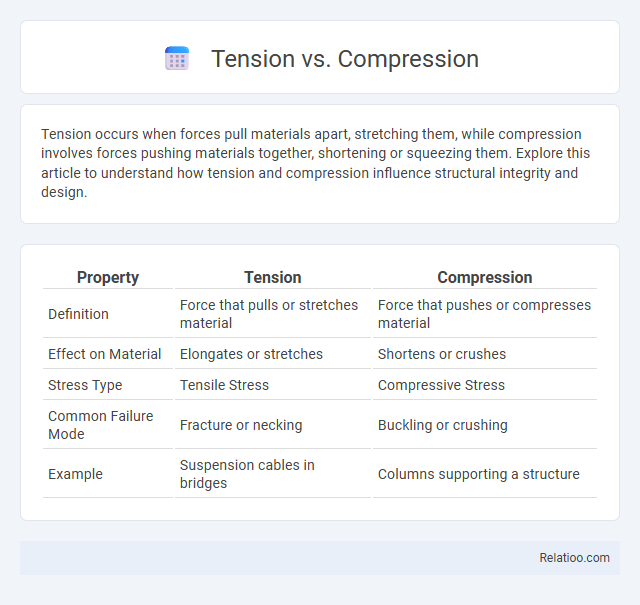Tension occurs when forces pull materials apart, stretching them, while compression involves forces pushing materials together, shortening or squeezing them. Explore this article to understand how tension and compression influence structural integrity and design.
Table of Comparison
| Property | Tension | Compression |
|---|---|---|
| Definition | Force that pulls or stretches material | Force that pushes or compresses material |
| Effect on Material | Elongates or stretches | Shortens or crushes |
| Stress Type | Tensile Stress | Compressive Stress |
| Common Failure Mode | Fracture or necking | Buckling or crushing |
| Example | Suspension cables in bridges | Columns supporting a structure |
Introduction to Tension and Compression
Tension and compression are fundamental mechanical forces that act on materials, influencing their structural behavior and integrity. Tension refers to forces that pull or stretch a material, causing elongation, while compression involves forces that push or squash a material, leading to shortening or deformation. Understanding how Your materials respond to these forces is crucial for designing safe and efficient structures in engineering and construction.
Defining Tension: Concepts and Examples
Tension refers to the force that stretches or elongates a material by pulling it apart, creating internal stress along its length. Examples of tension include cables supporting a suspension bridge or the strings of a guitar under strain. Understanding how tension affects Your structures or materials ensures proper design to prevent failure due to stretching forces.
Understanding Compression Forces
Compression forces act by pushing or squeezing materials together, causing a reduction in length or volume. These forces are critical in structural elements like columns and arches, where they help support loads by resisting deformation. Understanding compression is essential for designing materials and structures that can withstand crushing stresses without buckling or failing.
Key Differences Between Tension and Compression
Tension involves forces that pull a material apart, causing elongation, while compression involves forces that push a material together, resulting in shortening. Key differences include how materials respond structurally under these forces: tension often leads to stretching or failure by fracture, whereas compression can cause buckling or crushing. Understanding these distinctions is crucial for designing structures to withstand different load conditions effectively.
Real-World Applications of Tension
Tension occurs when forces pull materials apart, crucial in suspension bridges where steel cables bear loads and maintain structural integrity. Compression, by contrast, involves forces that push materials together, commonly seen in columns and arches supporting buildings and bridges. Understanding these forces helps you design safer structures and apply appropriate materials for varying stress conditions.
Real-World Applications of Compression
Compression forces play a critical role in structural engineering, where materials such as concrete and steel columns are designed to withstand heavy loads without buckling. In everyday applications, compression enables the stability of bridges, skyscrapers, and even your vehicle's suspension system, ensuring safety and durability. Understanding how materials respond to compression helps optimize designs for enhanced load-bearing capacity and longevity.
Materials Best Suited for Tension and Compression
Materials best suited for tension include steel and carbon fiber, known for their high tensile strength and ability to withstand pulling forces without breaking. Compression forces are effectively handled by materials like concrete and cast iron, which excel in resisting crushing and buckling under load. Your choice should consider the specific mechanical properties of each material to ensure optimal performance in tension or compression applications.
Structural Failures: Tension vs Compression
Structural failures predominantly arise from the opposing forces of tension and compression acting on materials. Tension stretches and elongates materials, causing cracks or fractures when the stress exceeds the material's tensile strength. Compression squeezes and shortens materials, leading to buckling or crushing once the compressive strength limit is surpassed, so understanding these forces is crucial for designing structures that safely withstand your load requirements.
Engineering Design Considerations
Tension involves forces that stretch a material, requiring designs to prioritize tensile strength and ductility to prevent elongation and failure, while compression subjects materials to crushing forces, demanding high compressive strength and stability to avoid buckling. Engineers must consider material properties, load paths, and factor safety differently for tension and compression to ensure structural integrity and performance under expected operational stresses. Combining tension and compression forces in design often necessitates careful analysis of stress distribution and potential points of weakness to optimize durability and safety.
Conclusion: Balancing Tension and Compression
Balancing tension and compression is essential for maintaining structural integrity and optimizing material performance. Your design should strategically distribute tension forces to avoid elongation and compression forces to prevent buckling, ensuring durability and safety. Properly managing these stresses enhances overall stability and extends the lifespan of engineering structures.

Infographic: Tension vs Compression
 relatioo.com
relatioo.com